

An encyclopedia of Middle-earth and Numenor

|
|
|
|
|
|
|
|
|
|
|
|
|
|
| |
|
 |

An encyclopedia of Middle-earth and Numenor |
 |

Pool formed by the Water. The Bywater Pool was located in the village of Bywater in the Shire. Another stream from the Northfarthing also fed the Bywater Pool. Sam Gamgee used to swim in the Bywater Pool with Rosie Cotton and her brothers. When he was parched with thirst in Mordor, he remembered the sparkling waters and cool mud of the Pool.
There were Hobbit-holes in the north
bank of the Pool with gardens that ran down to the water. The Bywater
Road ran close to the bank along Pool Side, the southern side of the
Pool. It was shaded by an avenue of trees. During the War
of the Ring, the trees along Pool Side were cut down and replaced with
ugly new houses and the Hobbit-holes in the north bank were abandoned and
neglected.
Sources:
The Fellowship
of the Ring: Map of "A Part of the Shire"
The Return
of the King: "Mount Doom, " p. 216; "The Scouring of the Shire," p.
283
Falls and lake forming the source of the River Narog. Eithel Ivrin was located in West Beleriand. The Falls of Ivrin cascaded from crystal springs down the southern face of the Ered Wethrin into a stone basin to form the Pools of Ivrin. The lake was in a wooded hollow, and the surrounding land was green and sheltered from the north by the mountains. Dor-lomin lay north of the mountains.
Eithel Ivrin was created in ancient times by Ulmo, Lord of Waters. His power guarded the waters from defilement. The waters of Eithel Ivrin were crystal clear and had healing powers.
The Feast of Reuniting was held by the Pools of Ivrin in the year 20 of the First Age. Fingolfin, the High King of the Noldor, invited Elves from throughout Beleriand to gather to discuss important matters and form friendships and alliances.
In 465, Beren and Finrod Felagund set out from Nargothrond on a quest to steal a Silmaril from Morgoth. They journeyed up the Narog to the Pools of Ivrin. Nearby, they found a camp of Orcs and killed them and took their gear. Disguised as Orcs, they entered the Pass of Sirion which was guarded by Sauron but they were captured. Finrod was killed but Beren was rescued by Luthien and Huan the Hound.
In 490, Gwindor brought Turin to Eithel Ivrin after Turin had mistakenly killed his friend Beleg. Turin was overcome by grief and madness, but when he drank from the Pools of Ivrin he was healed. They then set out downriver for Nargothrond where Finduilas, the woman Gwindor loved, dwelled. He called her Faelivrin after the gleam of the sun on the Pools of Ivrin.
Nargothrond was attacked in 495 by an army led by Glaurung the Dragon. Glaurung defiled Eithel Ivrin and poisoned the waters. The trees around the pool were burned and uprooted and the edges of the stone basin were broken so the waters spilled out to form a mire. A foul-smelling mist lay over the marshy land.
Turin passed Eithel Ivrin after the sack of Nargothrond and found the water to be undrinkable. He crossed paths with Tuor and Voronwe, who were on their way to Gondolin, but they did not speak to each other. Looking at the Pools of Ivrin, Tuor remembered that Ulmo had told him: "The springs are poisoned, and my power withdraws from the waters of the land." (UT, p. 37)
Names & Etymology:
The name Ivrin may mean
"crystalline." Eithel Ivrin means "Ivrin's Well." The
Falls of Ivrin and the Pools of Ivrin are
also referred to separately.
Sources:
The
Silmarillion: "Of the Return of the Noldor," p. 113; "Of Beleriand
and Its Realms," p. 119-20; "Of Beren and Luthien," p. 170; "Of Turin
Turambar," p. 209-10, 212, 215; "Of Tuor and the Fall of Gondolin," p. 239;
"Appendix - Element in Quenya and Sindarin Names," entry for eithel
Unfinished Tales: "Of Tuor and His Coming to Gondolin," p.
29, 37-38
The History of Middle-earth, vol. XI, The War of the
Jewels: "The Grey Annals," p. 34, 83, 85, 88-89, 91, 139-40,
145-46; "The Wanderings of Hurin," p. 256, 299-300 note 11
Gateway
to Sindarin by David Salo, p. 266
Hiswelókë's
Sindarin Dictionary
Forbidden Pool |
The Forbidden Pool in the New Line film |
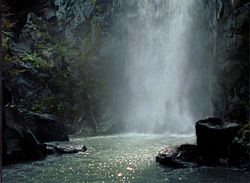
Pool in Ithlien. The Forbidden Pool was located below the hidden refuge of Henneth Annun. It was a deep, oval-shaped basin with rocks as sharp as knives on the bottom. The waterfall of Henneth Annuth flowed down the cliff on the eastern side and filled the pool. Water flowed out of the Forbidden Pool through a narrow opening in the rocks and formed a stream that flowed past the Field of Cormallen.
On March 8, 3019 of the Third Age, Gollum found the Forbidden Pool and dived into the water to catch fish. He was spotted by Anborn, a Ranger of Ithilien under Faramir's command. Faramir brought Frodo Baggins to a ledge overlooking the Forbidden Pool and asked whether he should have Gollum shot for trespassing in the pool of the Rangers' secret refuge.
Frodo asked Faramir to spare Gollum's
life and he went down to the edge of the pool and called to Gollum. When
Gollum came, Anborn seized him and Gollum felt betrayed by Frodo. Faramir
told Gollum that looking on the Forbidden Pool bore the penalty of death,
but at Frodo's request he released Gollum into Frodo's care.
Source:
The Two
Towers: "The Window on the West," p. 283; "The Forbidden Pool," p.
292-97 and passim
Lake in Eriador. Lake Evendim was in the Hills of Evendim north of the Shire. The lake was the source of the Brandywine River.
In the early part of the Second Age, Galadriel and Celeborn may have dwelled in the area around Lake Evendim with many Elves in their following before they moved to Eregion around the year 700. Men also lived around Lake Evendim in the early part of the Second Age. When the North-kingdom of Arnor was established in 3320, the High King Elendil had his seat at Annuminas on the shore of Lake Evendim near the mouth of the Brandywine. One of the palantiri was kept there.
After Arnor was divided into three
kingdoms in 861 of the Third Age, the capital was moved to Fornost.
Annuminas began to fall into ruin and was eventually abandoned. In the
Fourth
Age, Annuminas was reestablished as the northern capital by
Aragorn,
King Elessar. In the year 15 of the Fourth Age, the King and Queen
Arwen came north to dwell by the shores of Lake Evendim for a time.
Names &
Etymology:
Evendim means "evening twilight."
The Sindarin name was Nenuial meaning "lake of twilight" from nen
meaning "lake" and uial meaning "twilight."
Sources:
The Fellowship
of the Ring: "The Council of Elrond," p. 257
The Two
Towers: "The Palantir," p. 203
The Return
of the King: "Homeward Bound," p. 272-73
Appendix
A of The Lord of the Rings: "The Numenorean Kings: Numenor,"
p. 317; "The North-kingdom and the Dunedain," p. 324
Appendix
B of The Lord of the Rings: "The Tale of Years," p. 378
The Silmarillion:
"Of
the Rings of Power and the Third Age," p. 360; "Appendix: Elements in Quenya
and Sindarin Names," entry for uial
Unfinished
Tales: "The History of Galadriel and Celeborn," p. 234-35
The History
of Middle-earth, vol. XII, The Peoples of Middle-earth: "Of Dwarves
and Men," p. 313
Lake Helevorn |
Map of Lake Helevorn |
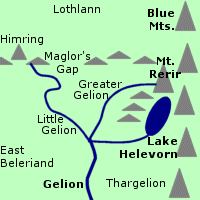
Lake in Beleriand. Lake Helevorn was located in the region of Thargelion on the western side of the Blue Mountains. It was a deep, dark lake at the southern foot of Mount Rerir, which stood out from the main range. Mountains overshadowed the lake on all but its southern side. A stream from the southern end of Lake Helevorn joined the Greater Gelion which in turn merged with the Little Gelion to form the Gelion.
After the Noldor came to Middle-earth at the dawn of the First Age, Caranthir settled around the shores of Lake Helevorn with his people. They built a fortress on the slopes of Mount Rerir above Lake Helevorn. Caranthir and his people were driven out by Morgoth's forces during the Battle of Sudden Flame in 455 and Lake Helevorn was defiled by Orcs.
Lake Helevorn no longer existed after the destruction of Beleriand in the War of Wrath at the end of the First Age.
Names & Etymology:
Lake Mithrim |
Map showing Lake Mithrim |
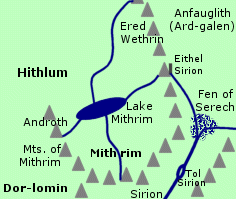
Lake in the region of Mithrim in southeastern Hithlum. Lake Mithrim was a long lake fed by four streams that came down from the mountains bordering Mithrim - three from the Ered Wethrin and one from the Mountains of Mithrim. The region of Mithrim was cool and misty with frequently overcast skies, and the land was grey and stony.
A group of Elves who had forsaken the Great Journey to the Undying Lands settled around the lake sometime after 1150 of the Years of the Trees. They became known by the name Mithrim because of the grey clothing they wore as camouflage in their stony surroundings and because of the grey skies where they lived. The region and the lake were named after them.
In 1497, Feanor came to Middle-earth to retrieve the Silmarils stolen by Morgoth. He and his followers settled on the northern shore of Lake Mithrim. The Elves of Mithrim welcomed their brethren the Noldor. They had difficulty communicating at first because the Mithrim spoke Sindarin and the Noldor spoke Quenya.
Morgoth sent an army to Mithrim but the Elves defeated them in the Battle-under-Stars. Feanor pursued the enemy back to Angband and was slain. His sons returned to Mithrim and fortified their camp.
At the start of the First Age, Fingolfin and his followers arrived in Mithrim. They had been abandoned by Feanor and had been forced to cross the Grinding Ice to Middle-earth. There was ill-feeling between the two groups of Noldor, so the sons of Feanor and their followers relocated to the southern shore of Lake Mithrim while Fingolfin's people settled on the northern shore. Around this time Morgoth sent poisonous mists to Hithlum which settled over the waters of Lake Mithrim.
In the year 7, the sons of Feanor left Mithrim and moved to East Beleriand. Fingolfin's people remained in Hithlum, and most of them dwelled near the shores of Lake Mithrim.
In the Battle of Unnumbered Tears in 472, most of the Noldor of Hithlum were slain or captured, and the survivors joined their kindred in Gondolin. Of the Elves of Mithrim who had gone to war, only Annael returned. A small number of Elves had remained in Mithrim. After the battle, Hithlum was occupied by Easterlings allied with Morgoth, and the Elves went into hiding in the Caves of Androth in the Mountains of Mithrim.
The Elves of Mithrim gave shelter to Rian who had lost her husband Huor - a Man of Dor-lomin. Rian gave birth to a son Tuor and left the child in the care of Annael and went to find Huor's grave, where she lay down and died.
In 488, Annael decided to lead his people out of Mithrim. When they left their caves they were attacked by Easterlings and Orcs, and Tuor was captured. Annael and the Elves were able to escape through the Gate of the Noldor and they settled at the Havens of Sirion. Tuor later escaped captivity and lived alone in the Caves of Androth until 495 when he too departed and made his way to Gondolin.
Lake Mithrim was destroyed with the rest of Hithlum in the War of Wrath at the end of the First Age.
Names &
Etymology:
The name Mithrim means "Grey-elves"
in Sindarin from mith meaning "grey" and rim meaning "host,
great number." Lake Mithrim originally meant "Lake of the Mithrim"
in reference to the Elves inhabiting the region around the lake. The Elves
were in turn named after the grey skies in the area and also for the grey
camouflage clothing the Elves wore.
Sources:
The Silmarillion:
"Of the Return of the Noldor," p. 106-12; "Of Beleriand and Its Realms,"
p. 119; "Of Turin Turambar," p. 198; "Of Tuor and the Fall of Gondolin,"
p. 238; "Appendix - Elements in Quenya and Sindarin Names," entries for
mith
and rim
The History
of Middle-earth, vol. XI, The War of the Jewels: "The Grey Annals,"
p. 17, 31, ; "Quendi and Eldar," p. 378, 410-11, 420 note 36
Unfinished
Tales: "Of Tuor and His Coming to Gondolin," p. 17-21, 25, 56 note
31
Body of water in Mordor. Nurnen was a large, dark lake or inland sea in the southeastern part of Mordor. At least four rivers or streams branched off Lake Nurnen. The area where Lake Nurnen was located was known as Nurn. This area was the most fertile region in Mordor, and there were fields around the shores of Lake Nurnen that were worked by slaves. After the War of the Ring, Aragorn, King Elessar, freed the slaves and gave them the lands around Lake Nurnen as their own.
Names &
Etymology:
On Tolkien's map of Middle-earth,
this body of water is called the Sea of Nurnen. In the text, it
is referred to as an inland sea but it is called Lake Nurnen.
Nurnen means "sad water" in
Sindarin. The word nurn means "lament" and the word
nen means
"water."
Sources:
Map of
Middle-earth by J.R.R. Tolkien
The Two
Towers: "The Black Gate Is Closed," p. 244
The Return
of the King: "The Land of Shadow," p. 201; "The Steward and the King,"
p. 247
Unfinished
Tales: Index entry for Nurnen (definition)
Book of
Lost Tales I: "Appendix - Names in the Lost Tales," entry for Nuri
(definition of nurn)
Lake in Nevrast on the coast of Beleriand. Linaewen was a large lake surrounded by the Marshes of Nevrast. The shoreline of Linaewen was indistinct. Numerous birds lived among the shallow pools and tall reeds around Linaewen.
Names &
Etymology:
The name Linaewen means "lake
of birds" from lin meaning "pool, mere" and aew meaning "small
bird" and en meaning "of the."
Sources:
The Silmarillion:
"Of Beleriand and Its Realms," p. 119; Index, entry for Linaewen;
"Appendix - Elements in Quenya and Sindarin Names," entry for lin (1);
Map of Beleriand
Unfinished
Tales: "Of Tuor and His Coming to Gondolin," p. 25
Lake in Wilderland. Long Lake was formed by the River Running south of its source in the Lonely Mountain. It was a very large, oval-shaped lake that had once been a deep rocky valley. At the southern end of the lake was a waterfall from which the River Running continued its course southward. The Forest River flowed into Long Lake from the west. Lake-town stood on piles in the waters on the west side of Long Lake near the mouth of the Forest River.
Long Lake was central to a system of waterways used to transport goods. Many goods were packed in barrels that were lashed together to form rafts that were steered up and down the waterways by raftmen. Commerce on the waterways thrived when the Dwarves of the Lonely Mountain and the Men of Dale prospered in the time of Thror and Girion.
In 2770 of the Third Age, Smaug the Dragon seized the Lonely Mountain and destroyed Dale. Trade continued on a much smaller scale between the Men of Lake-town and the Wood-elves of Mirkwood and the lands to the south. In 2941, Bilbo Baggins used the empty barrels sent by the Elves to Lake-town to help his Dwarf companions escape from Thranduil's prison. After Smaug was slain, Dain Ironfoot reestablished the Dwarf kingdom under the Mountain and Bard rebuilt Dale and the waterways became busy once more.
Lake-town was also rebuilt north of its former position in Long Lake. Smaug had landed on the town and destroyed it when Bard shot him. The Dragon's carcass remained in the waters of Long Lake and his bones could be seen in the shallows in calm weather. Few people dared to cross the water there, and no one dared to retrieve the gems that had fallen from Smaug's underbelly and lay at the bottom of the lake.
Sources:
The Hobbit:
"Barrels out of Bond," p. 188-89; "A Warm Welcome," p. 201-205; "Fire and
Water," p. 267; "The Last Stage," p. 316-17
Meres of Twilight |
Map of the Meres of Twilight |
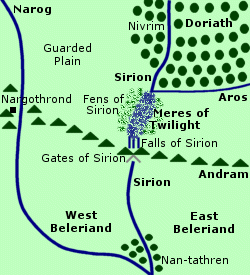
Pools formed by the River Siron in Beleriand. The Meres of Twilight were located just south of the point where the River Aros joined the Sirion. The Sirion slowed and broke up into many pools and channels. The Fens of Sirion spread outward from the Meres of Twilight. A heavy mist lay over the region.
The woodland realm of Doriath was north of the Meres of Twilight. Doriath was encircled by the protective barrier known as the Girdle of Melian, and the Meres of Twilight were encompassed by its enchantment. At the southern end of the Meres the river plunged over the Falls of Sirion and then passed through a tunnel under the Andram before emerging from the Gates of Sirion on the other side.
In the year 50 of the First Age, Turgon and Finrod stopped to rest by the Meres of Twilight on a journey along the Sirion. Ulmo, Lord of Waters, came up the river and sent them dreams urging them to establish hidden strongholds to defend against Morgoth. Turgon later founded Gondolin, while Finrod established Nargothrond 75 miles west of the Meres of Twilight.
Ferries were kept hidden in the reeds and creeks on the east side of the Meres of Twilights. They were used by messengers travelling between Doriath and Nargothrond. In 494, Morwen left Doriath to seek her son Turin. Mablung led a company of guards to protect her, while Morwen's daughter Nienor followed along in disguise. Mablung took them by ferry across the Meres of Twilight on their way to Nargothrond.
Names &
Etymology:
Also called the Twilight Meres
and Twilit Meres. The Sindarin name was Aelin-uial from aelin
meaning "pools, meres" and uial meaning "twilight."
Sources:
The Silmarillion:
"Of the Return of the Noldor," p. 114; "Of Beleriand and Its Realms," p.
122; "Of Beren and Luthien," p. 168; "Of Turin Turambar," p. 217; "Of the
Ruin of Doriath," p. 231; "Appendix - Elements in Quenya and Sindarin Names,"
entries for aelin and uial
Unfinished
Tales: "Narn I Hin Hurin," p. 114
The History
of Middle-earth, vol. V, The Lost Road and Other Writings: "The Etymologies,"
entries for AY, LIN1 and YU
MirrormereLake in the Dimrill Dale east of Khazad-dum. Mirrormere was a long, oval lake shaped like a spearhead. The lake stretched southward from the northern end of the valley. Around the lake a green lawn sloped down to the shore. The waters of Mirrormere were a deep, dark blue and the surface was flat and still. A stream called the Dimrill flowed into the northern end of Mirrormere from the slopes of Caradhras. At the southern end of the lake there was an icy spring fed by the waters of Mirrormere which was the source of the Silverlode. In ancient times, Durin- the eldest of the Seven Fathers of the Dwarves - came to the Dimrill Dale. He looked into Mirrormere and saw a crown of stars appear above the shadow of his head, and he decided to found the realm of Khazad-dum in the mountains above the valley. A column called Durin's Stone was erected to mark the spot where Durin first looked into Mirrormere. In 2889 of the Third Age, Balin led a company of Dwarves to recolonize Khazad-dum. On November 10, 2994, he went out to look into Mirrormere and was shot by an Orc. The rest of the colony perished soon afterwards. On January 15, 3019, Gimli led Frodo Baggins and Sam Gamgee to look into Mirrormere.
Names
& Etymology:
The Dwarves called the lake Kheled-zâram meaning "glass pool." The Dwarvish word kheled means "glass" and the word zâram means "pool." The Elvish name was Nen Cenedril which means "Lake Looking-glass" in Sindarin. Sources:The Fellowship of the Ring: "The Ring Goes South," p. 296; "A Journey in the Dark," p. 329; "Lothlorien," p. 347-48 The History of Middle-earth, vol. VI, The Return of the Shadow: "The Mines of Moria," p. 466 note 39 (Dwarvish and Sindarin etymology) |
Mirrormere by Barry Layman 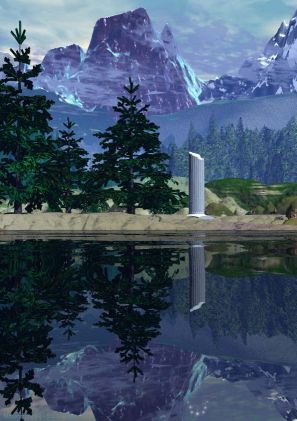 |
Nen Hithoel |
Nen Hithoel in the New Line film |
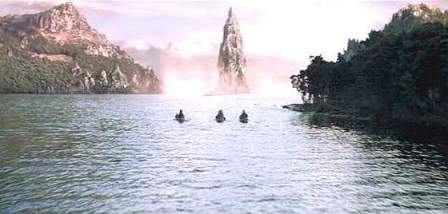
Lake formed by the Anduin. Nen Hithoel was a long, oval-shaped lake. The rugged land called the Emyn Muil spread out from both shores of Nen Hithoel. At the northern end of Nen Hithoel stood the Argonath, great statues of Isildur and Anarion that had been built to mark the northern boundary of Gondor. At the southern end of the lake were the Falls of Rauros.
The island called the Tindrock- or Tol Brandir - rose out of the waters of Nen Hithoel near the southern end. It was said that no man or beast had ever set foot on the island. Two hills stood opposite each other on either side of the lake: Amon Lhaw - the Hill of Hearing - on the eastern shore, and Amon Hen - the Hill of Sight - on the western shore. When Gondor was at its height, watch was kept from seats on the two hills. A green lawn called Parth Galen ran from the foot of Amon Hen to the banks of Nen Hithoel.
On February 25, 3019 of the Third Age, the Fellowship rowed down the Anduin into Nen Hithoel and camped at Parth Galen on the western shore. The next day, the Fellowship was broken and Boromir was slain. His body was placed in a boat on Nen Hithoel and the current carried it over the Falls of Rauros. Frodo Baggins and Sam Gamgee rowed across Nen Hithoel past the Tindrock to the eastern shore and they began their journey to Mordor.
Names &
Etymology:
Nen Hithoel means "mist-cool
water" in Sindarin. The word nen means "water" and hîth
means "mist." The final element oel apparently means "cool" although
this usage is not found elsewhere. The Etymologies list oel with
the meaning "pool, lake" but the spelling was later changed to ael.
Sources:
The Fellowship
of the Ring: "Farewell to Lorien," p. 384; "The Great River," p. 410;
"The Breaking of the Fellowship," passim
The Two
Towers: "The Departure of Boromir," p. 18-21
Appendix
A of The Lord of the Rings: "Gondor and the Heirs of Anarion,"
p. 326
The Journeys
of Frodo by Barbara Strachey: Map #26 - "Eastemnet and Nen Hithoel"
The Silmarillion:
"Appendix - Elements in Quenya and Sindarin Names," entry for HITH
Unfinished
Tales: Index entry for Emyn Muil, p. 434 ("Mist-cool Water")
The History
of Middle-earth, vol. V, The Lost Road and Other Writings: "The Etymologies,"
entry for AY (oel)
"Ae or Oe?"
on Ardalambion
Lake in Numenor. Nisinen was near the Bay of Eldanna on the west coast of Numenor. It was on the border of the coastal region of Nisimaldar. The lake was formed by the River Nunduine which flowed into the Bay of Eldanna. There appears to have been a small island in the center of the lake. Sweet-smelling shrubs and flowers grew in abundance on the shores of Nisinen.
Names &
Etymology:
The name Nísinen means
"fragrant water" in Quenya from níse or nísima
meaning "fragrant" and nen meaning "water."
Sources:
Unfinished
Tales: Map of Numenor; "A Description of the Island of Numenor," p.
167-68
The
Quenya Corpus Wordlist
The
Tolkien Language List
See Lake Nurnen.
Sea in eastern Middle-earth. The Sea of Rhun was a large inland sea located in Rhun, a land in far eastern Middle-earth. Wilderland was west of the Sea of Rhun. The River Running flowed from the Lonely Mountain into the Sea of Rhun.
In the southeastern part of the Sea of Rhun was a wooded island. There were mountains on the southwest side of the sea and a forest on the northeast side. Wild white kine, or oxen, lived near the shores of the Sea of Rhun. The Great Horn of Gondor was made from the horn of one of these kine that had been hunted by Vorondil, a Steward of Gondor.
When Gondor was at the height of its power during the reign of King Hyarmendacil I (1015-1149 of the Third Age), the realm extended east as far as the Sea of Rhun. But as Gondor's power waned, Easterlings came into the area around the Sea of Rhun and launched attacks on Gondor. In 1248, Minalcar (later called Romendacil II) defeated an army of Easterlings and destroyed their settlements near the Sea of Rhun. In 1944, an army of Wainriders gathered on the southern shores of the Sea of Rhun before launching an assault on Gondor that left King Ondoher dead.
During the War of the Ring, forces under the rule of Sauron mustered in the lands beyond the Sea of Rhun. After the downfall of Sauron, Aragorn, King Elessar, and King Eomer rode beyond the Sea of Rhun to flush out the last remnants of the enemy forces.
Names &
Etymology:
Also called the Inland Sea.
Rhûn
means "east" in Sindarin.
Sources:
Map of Middle-earth by J.R.R. Tolkien
The Return
of the King: "Minas Tirith," p. 38
Appendix
A of The Lord of the Rings: "The Realms in Exile - The Southern Line"
p. 319 (footnote 1); "Gondor and the Heirs of Anarion," p. 325-26; "The
House of Eorl," p. 352
Unfinished
Tales: "Cirion and Eorl," p. 290, 292, 296
Tarn Aeluin |
Map of Tarn Aeluin |
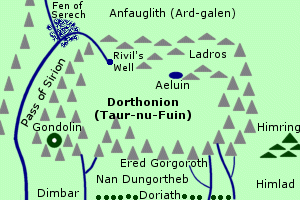
Lake in Dorthonion. Tarn Aeluin was located in the wild heaths in the eastern highlands of Dorthonion. It was a clear blue lake whose waters reflected the stars at night. According to legend, Tarn Aeluin was hallowed by Melian, a Maia from the Undying Lands who married King Thingol of Doriath south of Dorthonion.
Around the year 7 of the First Age, Dorthonion was settled by Elves led by Angrod and Aegnor. The Men of the House of Beor came to Dorthonion, and in 410 they were given the region of Ladros northeast of Tarn Aeluin. No one lived in the wild lands around Tarn Aeluin.
Aegnor fell in love with a woman of the House of Beor named Andreth but they parted because he was immortal and she was mortal. Their last meeting was on the shores of Tarn Aeluin.
In 455, Dorthonion was attacked by Morgoth in the Battle of Sudden Flame. Most of the inhabitants died or fled, but Barahir of the House of Beor stayed with some of his people. They were hunted down until only twelve Men remained with Barahir: his son Beren, his nephews Baragund and Belegund, and nine others named Radhruin, Dairuin, Dagnir, Ragnor, Gildor, Gorlim, Arthad, Urthel, and Hathaldir. They took refuge in a hidden lair near Tarn Aeluin.
In 460, Sauron tricked Gorlim into revealing the location of the lair by pretending Gorlim's dead wife Eilinel was alive and in captivity. Orcs attacked the lair before dawn and killed Barahir and his companions. Beren was away on a mission, but he dreamed of a lake surrounded by carrion-birds in trees, and Gorlim's spectre came across the water to warn him.
Beren returned to Tarn Aeluin too late and found the bodies of his kin. Carrion-birds alighted in the trees as in his dream. He buried his father near the lake under a cairn of stones, and then he hunted down the Orcs and slew their captain and retrieved his father's ring.
Dorthonion had become a place of evil and was known as Taur-nu-Fuin, the Forest under Night. After Beleriand sank beneath the Sea in the War of Wrath at the end of the First Age, the highlands of Taur-nu-Fuin stayed above water as the island of Tol Fuin. It is not known whether Tarn Aeluin remained on the island.
Names &
Etymology:
The name Aeluin means "blue
lake" in Sindarin from ael meaning "lake, pool, mere" and luin
meaning "blue." The word tarn means "small mountain lake" in English.